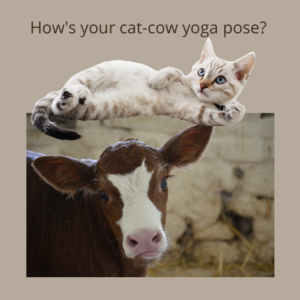Cat/cow pose can be a lovely movement for the body. Some things to watch out for: – Keep it soft – any feeling of “stretching” wants to be a lengthening expansive feeling i.e. a natural and body-lead movement. Imagine you’re the cat stretching, it’s a pandiculation. Watch your head – it’s easy to scrunch up the back of the neck.

Often, I don’t go with the looking up part, but keep letting the neck lengthen in its natural location in relation to the rest of the spine. As the mid back moves lower than the hips and shoulders, instead of looking up, leave your neck alone, unlock your jaw and soften your tongue – you might notice more freedom in the spine. Free pelvis – Experiment with letting the front of the pelvis go, (think “soften”), whilst thinking the back to widen. This is especially useful in the forward curve part of the move, where your mid back rises. If you’re next to a mirror, take a side glance to see if you really are allowing the lower and mid back to gently curve. We can sometimes end up increasing a hunch in the upper back – not so useful. I love the thinking direction of “soft belly and wide back”. You’re aiming for a long languid curve of the spine, in both the up and down position. Get next to a mirror and see if you’re achieving that. Often, we’re just allowing one section of the back to move. e.g. rounding the upper back or collapsing the lower back, this isn’t what we want. There’s a point at which you’re in the table top pose, notice this. Are you still breathing or have you held your breath? Above all, it should be a slow movement that feels good.
Waking up your internal support is part of the relearning that you experience with the Alexander Technique.
